

National Museum of Australia. Why a ‘white Australia’?
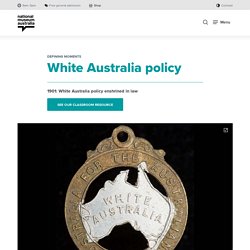
In the 1800s the majority of the white population of the Australian colonies shared attitudes towards people of different races that by today’s standards were openly racist. Criticisms of non-white groups were based on the idea that they were less advanced than white people in all ways, especially morally and intellectually. In Australia, this idea focused particularly on people of Asian descent but applied to all non-whites, including Indigenous Australians, who were considered a ‘dying race’. Ironically, Australia saw itself as a utopia and a working man’s paradise, a forward-thinking country that promoted equal rights and opportunities, for ‘desirable’ citizens at least. The nation aimed to attract a well-paid, male, white and skilled labour force to uphold this image.
Non-whites, and even sometimes working women, were seen as a threat to this ideal. Australia’s migration history - from 'White Australia' to multiculturalism. Australia’s migration history The nineteenth century In 1788, when European settlement began, Australia’s Aboriginal population was about 400,000.
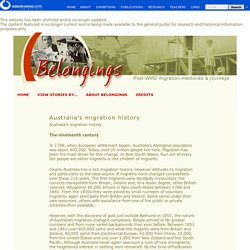
Today, over 20 million people live here. Migration has been the main driver for this change. The Immigration Restriction Act 1901. The Immigration Restriction Act 1901, also known as the White Australia policy, affected migrants who came to Australia between 1901 and 1958. The National Archives holds records that show how: the Act affected people’s livesmigrants negotiated the conditions of the Actcommunity attitudes to the Act changedthe Act had a negative affect on Australia’s relationship with Asian countries. These records are useful for social, political and family history researchers. Why Australia wanted a White Australia policy - ABC Education.
The White Australia policy is one of the most embarrassing features of Australian history in the 20th century.
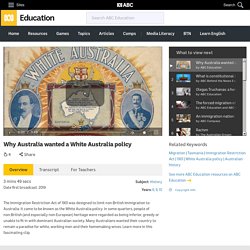
It had its origins in the late 19th century when the main group that we wanted to exclude were the Chinese. People don't realise that one of the first acts of the new commonwealth parliament-- the first act was to pass the Immigration Restriction Act 1901, which was really the legal basis for the White Australia policy. So long as we possibly can, we ought to aim at having a homogeneous population. And it was very controversial at the time because Britain said, we don't think you should pass that policy because we have an alliance with Japan. National Museum of Australia. Populate or perish When Japan entered the Second World War in December 1941 its troops quickly moved south, occupying much of South-East Asia and the Pacific.
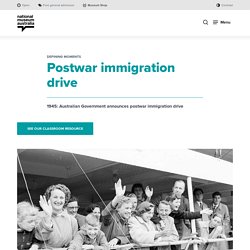
Singapore fell in February 1942 and Darwin was bombed shortly after. Immigration Nation - everything you need to know about immigration. Effects of the White Australia policy in the Northern Territory. Origins: History of immigration from Indonesia - Immigration Museum, Melbourne Australia. Map date: 2013 Before white settlement of Australia, Indonesian fishermen from Makasar established trading contact with Indigenous communities in northern Australia.
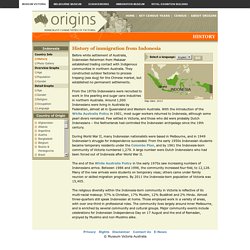
They constructed outdoor factories to process trepang (sea slug) for the Chinese market, but established no permanent settlements. Chapter 1: Immigration 1901–39: An Overview - More People Imperative: Immigration to Australia, 1901–39. Immigration has been a vital feature of Australia's history and identity.
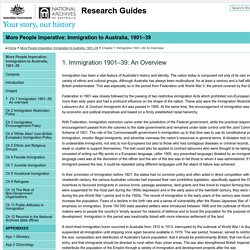
The nation today is composed not only of its own indigenous peoples but a wide variety of ethnic and cultural groups. Although Australia has always been multicultural, for at least a century and a half after European settlement, the British predominated. This was especially so in the period from Federation until World War II, the period covered by this Guide. Federation in 1901 was closely followed by the passing of two restrictive immigration Acts which prohibited non-European immigration to Australia for more than sixty years and had a profound influence on the shape of the nation.
The changing face of modern Australia – 1900s to 1940s. Italian workers at a knitting factory.

Image courtesy of the Migration Museum, History Trust of South Australia. The hundreds of thousands of people who arrived in Australia after the First World War greatly influenced Australia becoming a modern society. They brought with them skills, commitment to family, education and their own cultural values. Their experiences in Australian created new ways of eating in cafés and milk bars, new public buildings, new approaches to leisure, new concepts of design and architecture and new sounds—jazz music. The changing face of modern Australia – 1950s to 1970s. After the Second World War (1939–45) the Australian government committed to a vigorous and sustained immigration program.
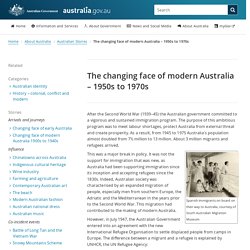
The purpose of this ambitious program was to meet labour shortages, protect Australia from external threat and create prosperity. As a result, from 1945 to 1975 Australia's population almost doubled from 7½ million to 13 million. About 3 million migrants and refugees arrived. Spanish immigrants on board on their way to Australia, courtesy of South Australian Migration Museum This was a major break in policy.
However, in July 1947, the Australian Government entered into an agreement with the new International Refugee Organisation to settle displaced people from camps in Europe. Economic migrants normally leave a country voluntarily to seek a better life. Key moments in Victoria's immigration History - Museums Victoria. In 2012, the Australian Government resumes off-shore processing of asylum seekers and re-opens detention centres on Nauru and Manus Island, Papua New Guinea in response to increased numbers of boat arrivals and deaths at sea.
In 2013 the entire Australian mainland is excised from the migration zone in a bid to deter the onshore arrival of asylum seekers. The Australian Government launched `Operation Sovereign Borders’ in 2013, reflecting the military-led approach to deterring people-smuggling activities and boats coming to Australia. 2013-14 India, China, and the UK are the top source countries for the Australian Migration Program; China and India also filling the majority of the student visa places. In 2014, Iranian national Reza Berati dies in a violent raid at Manus Island detention centre, and many others require medical attention. An Australian Government investigation is launched. Timeline: Australia's Immigration Policy. 1831 – 43 years after the arrival of the First Fleet and the beginning of British colonisation in Australia, the first assisted migration begins with workers from Britain encouraged to apply.
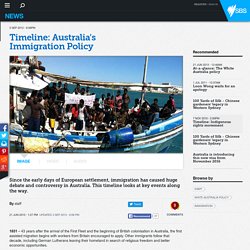
Other immigrants follow that decade, including German Lutherans leaving their homeland in search of religious freedom and better economic opportunities. 1860 – Many Chinese miners take advantage of Australia's Gold Rush, but it causes tensions that come to a head in an 1860 riot. 3,000 European miners drive the Chinese off the Burrangong Goldfield in New South Wales. 1888 – Tensions continue over Chinese workers and in 1888 the Premiers of all the pre-Federation colonies (except Tasmania) agree to further restrict Chinese immigrants. Australia's Migration Program. Updated 29 October 2010 PDF version [350KB] Harriet SpinksSocial Policy Section Contents Introduction.

Refugees and the Australian Government - International law & Migration Act. International law. Australia's migration history timeline. Australia wants, and will welcome, new healthy citizens who are determined to become good Australians.Arthur Caldwell, Australian Minister for Immigration, 1945 British migrants arrive in Sydney on the Fairsea, c.1963. Courtesy National Archives of Australia After World War II ended in May 1945 Europe was in chaos. An immigration nation - ABC Education. Migrant contributions honoured with new Australia Day award. Bhutanese refugee Parsu Sharma-Luital has worked tirelessly with refugees and asylum seekers, but he says his work is not done. "The signal sends a very positive message, and we can very proudly say, 'Australia we are one more step ahead of multiculturalism'," Parsu says.
Parsu first arrived in Australia in 2002. He came to study a masters degree and on the advice of University staff, the horticulturalist soon sought asylum to escape the unrest in his native Bhutan, which left many stateless. "My parents lived 18 years in the camp, my father had gone to prison because he was considered one of the activists. " He became an Australian citizen in 2008, but his community work started long before then.
"When I saw many refugees suffer in the refugee camp in Nepal, and then our own people...and I felt we should do something and when I came here I wanted to carry out this sort of activity. " But Parsu's achievements extend beyond his work within emerging communities. Why migrants may be our greatest economic asset - The Drum. Opinion Posted Forget the myths. Migrants lift the three "Ps" of high economic growth - population, participation and productivity. So maybe we need to increase our intake, writes Patrick Carvalho. Immigration impacts Australia allbw. Chinatowns across Australia.